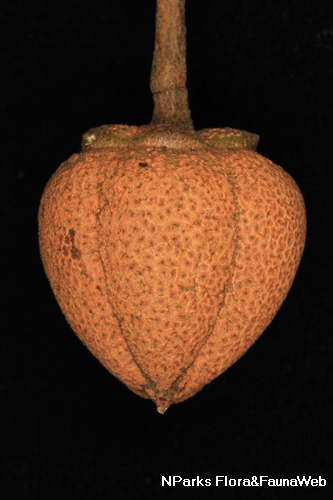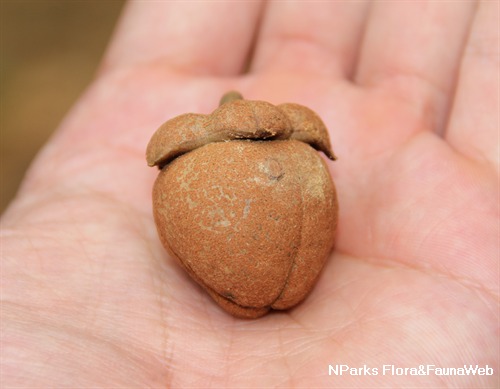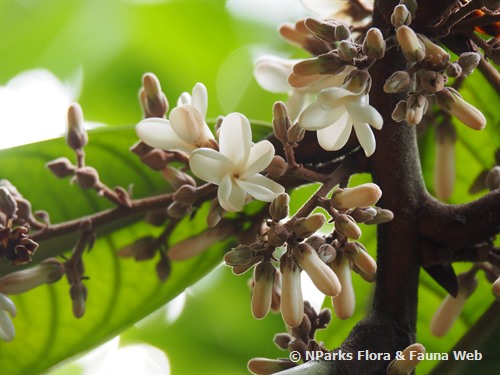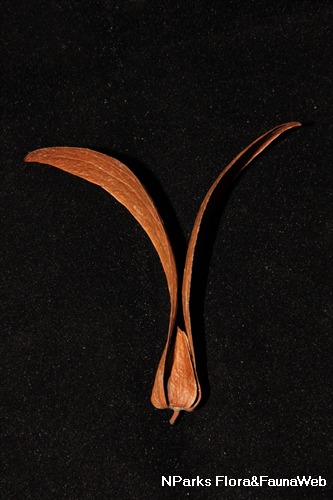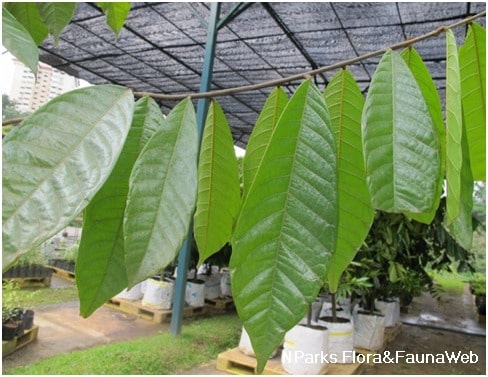
Back
Vatica venulosa Blume
| Family Name: | Dipterocarpaceae |
| Synonyms: | Dryobalanops schefferi Hance, Vatica bancana Scheff., Vatica kunstleri Brandis, Vatica lutea Ridl., Vatica schefferi Brandis, Vatica schouteniana Scheff., Vatica simalurensis Sloot |
| Common Name: | Rasak, Rasak Saluang, Resak, Resak Air, Resak Kayu Api, Resak Letop |
Name
Classifications and Characteristics
| Plant Division | Angiosperms (Flowering Seed Plants) |
|---|---|
| Plant Growth Form | Tree |
| Lifespan (in Singapore) | Perennial |
| Mode of Nutrition | Autotrophic |
| Maximum Height | 35 m |
Biogeography
| Native Distribution | Peninsular Malaysia, Sumatra, Borneo, and Java. |
|---|---|
| Native Habitat | Terrestrial (Riverine, Freshwater Swamp Forest, Inland Cliff, Primary Rainforest) |
| Preferred Climate Zone | Tropical |
| Local Conservation Status | Non-native (Horticultural / Cultivated Only) |
Description and Ethnobotany
| Growth Form | It is a tree, up to 35 m tall. |
|---|---|
| Foliage | Its stalked, alternately-arranged leaves are elliptic to ovate-lanceolate in shape, thinly leathery, 4-12 cm long and 1.5-5 cm wide. Its stipules and petioles are covered with short, dense, pale pink-brown hairs. |
| Flowers | Its flowers are 5-petaled, pale creamy white in colour, borne on stalked inflorescences. |
| Fruit | Its fruits are round nuts, that are about 1 cm wide, covered completely by the persistent calyx. |
| Habitat | It grows in tropical, lowland dipterocarp forests on hills, valleys and along streams up to 500 m in altitude. |
| Associated Fauna | Its flowers are pollinated by insects. |
| Cultivation | It can be propagated by seed. |
| Etymology | Latin Vatica, soothsayer. Latin venulosa, with fine veins. |
Landscaping Features
| Landscaping | It is suitable for parks and riverine parks. |
|---|---|
| Landscape Uses | General, Parks & Gardens, Riverine |
Fauna, Pollination and Dispersal
| Pollination Method(s) | Biotic (Fauna) |
|---|---|
| Seed or Spore Dispersal | Abiotic |
Plant Care and Propagation
| Light Preference | Full Sun, Semi-Shade |
|---|---|
| Water Preference | Moderate Water |
| Plant Growth Rate | Moderate |
| Rootzone Tolerance | Moist Soils, Well-Drained Soils, Fertile Loamy Soils |
| Maintenance Requirements | Moderate |
| Propagation Method | Seed |
Foliar
| Foliage Retention | Evergreen |
|---|---|
| Mature Foliage Colour(s) | Green |
| Mature Foliage Texture(s) | Leathery, Thin |
| Foliar Modification | Stipule |
| Foliar Type | Simple / Unifoliate |
| Foliar Arrangement Along Stem | Alternate |
| Foliar Attachment to Stem | Petiolate |
| Foliar Shape(s) | Non-Palm Foliage (Lanceolate, Elliptical) |
| Foliar Venation | Pinnate / Net |
| Foliar Margin | Entire |
| Foliar Apex - Tip | Acuminate |
| Foliar Base | Cuneate |
Floral (Angiosperm)
| Flower & Plant Sexuality | Bisexual Flowers |
| Flower Colour(s) | Cream / Off-White |
|---|---|
| Flower Grouping | Cluster / Inflorescence |
| Flower Location | Axillary |
| Flower Symmetry | Radial |
| Inflorescence Type | Panicle |
Fruit, Seed and Spore
| Mature Fruit Colour(s) | Brown |
|---|---|
| Fruit Classification | Simple Fruit |
| Fruit Type | Indehiscent Dry Fruit , Nut / Nutlet |
Image Repository
Others
| Master ID | 31676 |
|---|---|
| Species ID | 6075 |
| Flora Disclaimer | The information in this website has been compiled from reliable sources, such as reference works on medicinal plants. It is not a substitute for medical advice or treatment and NParks does not purport to provide any medical advice. Readers should always consult his/her physician before using or consuming a plant for medicinal purposes. |

